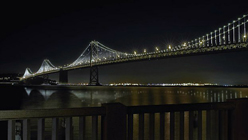After two years of elaborate logistics and private fundraising, New York-based artist Leo Villareal’s The Bay Lights, a site-specific light installation on the western span of the San Francisco-Oakland Bay Bridge, will be lit on March 5, 2013. The work will be visible as a kinetic light display every evening from dusk to midnight for the next two years. It promises the world’s largest light sculpture at nearly two miles wide and 500 feet high; it consists of 25,000 individually programmed white LED lights. Despite its scale, the project is designed to be unobtrusive to drivers on the bridge. There is no doubt it will instigate a wide reaching dialog on the value of art in a way the Bay Area has never seen before. Its sheer accessibility, visible from miles away, promises to outshine the best efforts of any institution within or beyond the city.
Leo Villareal is widely known for his light installations and architectural interventions. He recently created large-scale works for the National Gallery of Art in Washington D.C. and in Madison Square Park in New York. The notion to use the Bay Bridge as the framework for a grand artistic gesture was initially conceived by Bay Area artist Ben Davis, founder and owner of the San Francisco creative marketing agency Words Pictures Ideas. Once introduced to Villareal’s work by Zero1 curator Dorka Keehn, Davis became the driving force behind the project. The realization of The Bay Lights is a testament to an admirable force of will, from the artist to the organizers to the fleet of personalities involved including representatives from city agencies, transit workers, engineers, programmers, electricians and more.
People will love it or hate it, to be sure. For the last several weeks, the public has been given previews of the project during test runs on select evenings. Unfavorable comparisons have already been made to the theatrical aquatics of Las Vegas casinos. Light pollution activists have voiced objections on the grounds that the project interferes with stargazing. Others grumble about the wealth of private resources directed at the project — $6 million of the $8 million fundraising goal has been reached — while still others find the project lacking in intellectual complexity.
But the fact that it promises to be contentious makes it seem more promising than any other grand gesture in recent memory. When everyone agrees, the subject is quickly changed. In this regard, perhaps The Bay Lights offers more complexity than initial perceptions allow because it certainly does not promise a consensus. But it does make other huge promises, on par with its scale. The website asserts that more than 50 million people in the Bay Area will be impacted, with billions more seeing the project in the media and online. It also estimates that $97 million will be added to the local economy, presumably through hospitality and tourism revenue.


